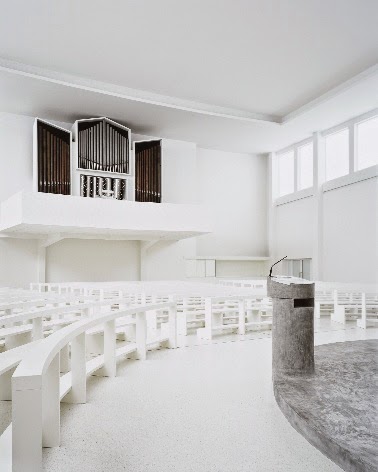In Catholic circles we find discussions
and much written material on Christian sacred architecture, and in
many cases it has a practical outworking: What should the church look
like, how does it meet the needs of the congregation, how does it
meet the need in the liturgical theatre, or what does it express?
In an online journal, Sacred
Architecture, issue 21, Steven Schloeder, discusses the
implications of a Domus Dei versus Domus ecclesia - a building with
the primary function as a house of God or as a meeting place for the
congregation. Naturally, there is no necessary opposition between the
two, but there is clearly an emphasis on what is important. Schloeder
explains the sentiment in the modern approach, which stresses the
need for the architecture to mirror contemporary taste and meet human
needs, but he also laments the breach away from traditions in
building that has defined the church for 1700 years.
What does a modern church building
signify? Its exterior in steel, glass and concrete resembles any
other office building, but there may be a symbol, a cross, which
signals its ecclesiastical use. The exterior has a message to the
outsiders, and to the local community: does it signal the ordinary,
the commonality with 'this world', or does it signal an entry into
the realm of heaven? Contemporary church architecture has variations
in style, and may be more an expression of the individual architect
than a strong cultural trend, which, then may be called an individual
trend.
 |
| Christ Resurrection Church, Milan, Italy. |
Style may be individually flavoured,
but a church has its functions. As such, it is meant to be
experienced from the inside. The question remains: does it function
as a Domus ecclesia, with room and opportunity for the congregation
to interact, to learn, to be a fellowship? If so, the question
arises: a fellowship, of what? Are we talking about a club of people
who share common interests? Are we talking about a human need centred
gathering, where - in some cases the seating is cushioned, laid out
like a theatre, with room for coffee mugs - and the congregation
become an audience to a performance...? What is the architecture
suggesting to people? What is their response?
 |
| Interior: St. Bonifatius, Herbrechtingen, Germany. |
 |
| Thomas Road Baptist Church, Lynchburg, Virginia, USA |
A
fellowship of believers is just that: a fellowship of people who have common faith, and who come to fellowship with God, together. They may have little in common in many other aspects of life, but they have this central and defining faith in common. Therefore they come to church: to worship, to receive forgiveness for sins, to be edified and built up in the faith. This time functions as a life support for many. Their deepest need is communion with God, encouragement - or even correction. How will the architecture help to direct the focus on God?
In my opinion, the answer is not
necessarily in tradition, in tall majestic stone buildings. The
architecture needs to be deliberate, in direction of movement and in
primary focus. It needs to be deliberate in use of light, and it in
auditory functions. The interior vessels and furnishings, whether
they are elaborate or minimalistic in style, need to serve their
primary purpose. If it aides the believer individually and as a
community to focus on God, and as a consequence, builds up the
believers, then the architecture has served its function.
In the Orthodox church traditions,
there is not as much change in styles. The expression in
architecture has remained much the same, as have the age old rituals
in the liturgies. It is awe inspiring in its beauty and splendour;
for the space is sacred space, and the time is not temporal in
earthly sense. Stepping in to the sanctuary means to step into a holy
place, beyond the limits of this world, both in time and space. There
is the solemn encounter with the King of Heaven, of the risen and
victorious Christ. This is a Domus Dei.
 |
| Church of the Saviour on Spilled Blood (Cathedral of the Resurrection of Christ) in St. Petersburg, Russia. |
 |
| Church of the Saviour of the Spilled Blood |
Ingen kommentarer:
Legg inn en kommentar